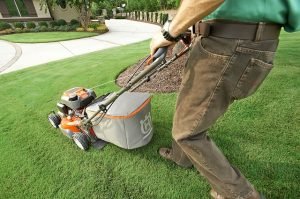Continuing my new series of articles for 2019, Materials For A Purpose, I am going to be discussing how to choose the right materials and how they best fit into the design of a space. This month I want to explore edging materials and how they can be used effectively to give definition to a space.
 Retaining edges are really important to stop ingress of unwanted materials spilling out into a space. Bark is very popular as a mulch in the garden, but it does have a tendency to move between spaces if it is not retained with an edge. Depending on the style of the space something as simple as tantalised timber edging sunk in the ground will reduce the amount of bark moving onto a lawn. The finishing height is important, if your edge is too low the materials will continue to move, but also if too high it will stand out. When we build new gardens, we adjust the ground height to fit. Installation of an edge in an established garden could require changes to the levels to allow the edge to function. Migration of gravel can be easily prevented by using an edge. I am a big fan of old-style red brick pavers, not only do they define an edge they look great too! Indian sandstone continues to be very popular in gardens and can be supplied as 100 x 100 mm setts. Last summer we used granite setts in a contemporary city garden to define the edge of the paving and retain the planting borders. The colour helped connect with the gun metal grey window fixtures and provided harmony of materials in the design.
Retaining edges are really important to stop ingress of unwanted materials spilling out into a space. Bark is very popular as a mulch in the garden, but it does have a tendency to move between spaces if it is not retained with an edge. Depending on the style of the space something as simple as tantalised timber edging sunk in the ground will reduce the amount of bark moving onto a lawn. The finishing height is important, if your edge is too low the materials will continue to move, but also if too high it will stand out. When we build new gardens, we adjust the ground height to fit. Installation of an edge in an established garden could require changes to the levels to allow the edge to function. Migration of gravel can be easily prevented by using an edge. I am a big fan of old-style red brick pavers, not only do they define an edge they look great too! Indian sandstone continues to be very popular in gardens and can be supplied as 100 x 100 mm setts. Last summer we used granite setts in a contemporary city garden to define the edge of the paving and retain the planting borders. The colour helped connect with the gun metal grey window fixtures and provided harmony of materials in the design.
Mowing strips are a great way to define the shape of a lawn and make the maintenance simple. I love to have shape to the lawn but if not well maintained the edge and definition can be easily lost. By adding a course of engineering bricks or setts it allows the mower to pass over and avoids having to cut the grass edge with shears. It is a great time saver for contemporary gardens where repetition of materials is key. I would normally want to use the same sett or brick material as the paving selection. Metal edges have become very popular too to retain a prescribed shape to a lawn. There are many products, but I like to use lengths of steel edging cut and welded to fit.
Transitions from one space to the next can be accentuated by using edging materials. In modern garden design it is often talked about creating garden rooms, but for these to fit together the change needs to be marked. Stepping up or down into a new space, or passing under an arch are classic ways to mark a transition between spaces. However, a simple change of edging material at the transition point is very effective too. For example, an oak sleeper on edge could be used when stepping off a paved area onto a curving path of timber with gravel in fill.
Planting is a softer way to form an edge and can be over looked as a way to define a space. I prefer to use plants where possible to create a softer feel. Low hedging such as Box or Berberis can make an excellent edging and provide low enclosure. Repetition of hardy perennials will work well too. I have lost count of the numbers of times I have seen catmint / Nepeta ‘Six Hills Giant’ used in gardens, but it is effective. Edging does not have to be flat and low. I love to define edges of space with hedges of plants such as Beech, Hornbeam or Yew. The taller edging will provide more enclosure and privacy to a space and thus change the atmosphere of that space, but it is all edging. Planting your boundary with a native hedgerow mixture is great for the wildlife and is edging too. Think outside the box!













